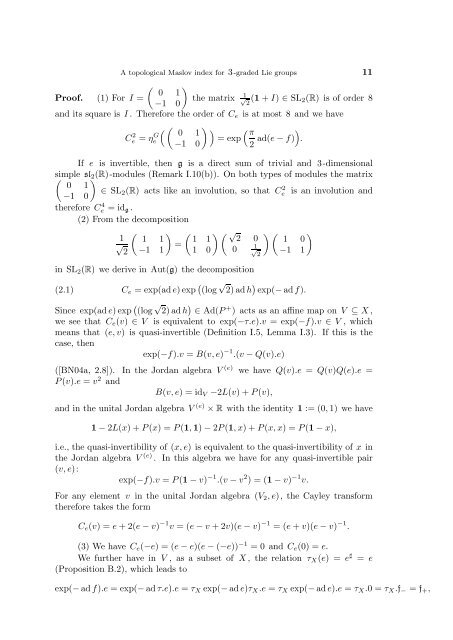A topological Maslov index for 3-graded Lie groups - ResearchGate
A topological Maslov index for 3-graded Lie groups - ResearchGate
A topological Maslov index for 3-graded Lie groups - ResearchGate
You also want an ePaper? Increase the reach of your titles
YUMPU automatically turns print PDFs into web optimized ePapers that Google loves.
A <strong>topological</strong> <strong>Maslov</strong> <strong>index</strong> <strong>for</strong> 3-<strong>graded</strong> <strong>Lie</strong> <strong>groups</strong> 11<br />
Proof.<br />
<br />
0<br />
(1) For I =<br />
−1<br />
<br />
1<br />
0<br />
and its square is I . There<strong>for</strong>e the order of Ce is at most 8 and we have<br />
C 2 e = η G <br />
e<br />
0<br />
−1<br />
<br />
1 π<br />
<br />
= exp ad(e − f) .<br />
0 2<br />
the matrix 1<br />
√ 2 (1 + I) ∈ SL2(R) is of order 8<br />
If e is invertible, then g is a direct sum of trivial and 3-dimensional<br />
simple sl2(R)-modules (Remark I.10(b)). On both types of modules the matrix<br />
0 1<br />
∈ SL2(R) acts like an involution, so that C<br />
−1 0<br />
2 e is an involution and<br />
there<strong>for</strong>e C4 e = idg.<br />
(2) From the decomposition<br />
√ <br />
1 1 1 1 1 2 0 1 0<br />
√ =<br />
1<br />
2 −1 1 1 0 0 √2 −1 1<br />
in SL2(R) we derive in Aut(g) the decomposition<br />
(2.1) Ce = exp(ade) exp (log √ 2) adh exp(−adf).<br />
Since exp(ade) exp (log √ 2) adh ∈ Ad(P + ) acts as an affine map on V ⊆ X ,<br />
we see that Ce(v) ∈ V is equivalent to exp(−τ.e).v = exp(−f).v ∈ V , which<br />
means that (e, v) is quasi-invertible (Definition I.5, Lemma I.3). If this is the<br />
case, then<br />
exp(−f).v = B(v, e) −1 .(v − Q(v).e)<br />
([BN04a, 2.8]). In the Jordan algebra V (e) we have Q(v).e = Q(v)Q(e).e =<br />
P(v).e = v 2 and<br />
B(v, e) = idV −2L(v) + P(v),<br />
and in the unital Jordan algebra V (e) × R with the identity 1 := (0, 1) we have<br />
1 − 2L(x) + P(x) = P(1,1) − 2P(1, x) + P(x, x) = P(1 − x),<br />
i.e., the quasi-invertibility of (x, e) is equivalent to the quasi-invertibility of x in<br />
the Jordan algebra V (e) . In this algebra we have <strong>for</strong> any quasi-invertible pair<br />
(v, e):<br />
exp(−f).v = P(1 − v) −1 .(v − v 2 ) = (1 − v) −1 v.<br />
For any element v in the unital Jordan algebra (V2, e), the Cayley trans<strong>for</strong>m<br />
there<strong>for</strong>e takes the <strong>for</strong>m<br />
Ce(v) = e + 2(e − v) −1 v = (e − v + 2v)(e − v) −1 = (e + v)(e − v) −1 .<br />
(3) We have Ce(−e) = (e − e)(e − (−e)) −1 = 0 and Ce(0) = e.<br />
We further have in V , as a subset of X , the relation τX(e) = e ♯ = e<br />
(Proposition B.2), which leads to<br />
exp(−ad f).e = exp(−ad τ.e).e = τX exp(−ade)τX.e = τX exp(−ade).e = τX.0 = τX.f− = f+,

















